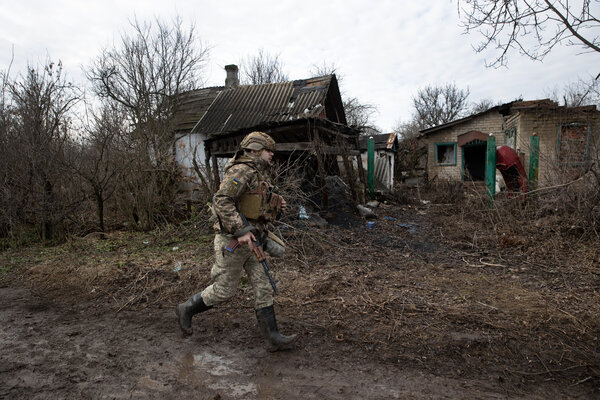
BRUSSELS — Western leaders sought to deter a full-scale Russian invasion of Ukraine by punishing prominent members of President Vladimir V. Putin’s inner circle on Wednesday, imposing new sanctions and promising worse penalties should the Kremlin begin a new military offensive.
The European Union revealed new sanctions on Russia’s defense minister, Sergei K. Shoigu; Mr. Putin’s chief of staff, Anton Vaino; and high-profile Russians from the media world. The White House planned to announce another round of sanctions as well, including on the company building the gas pipeline connecting Russia to Germany.
European officials said the sanctions were a first step toward punishing those involved in the recognition of the so-called republics of Donetsk and Luhansk on Monday, which the bloc regards as a violation of Ukraine’s territorial integrity.
In Ukraine’s capital, Kyiv, civilian and military leaders braced for all-out war as military reservists were called up, officials prepared to declare a 30-day state of emergency and the government urged Ukrainian citizens in Russia to leave the country. Russia’s Foreign Ministry said it would evacuate diplomats from Ukraine and Mr. Putin, in a video speech released on Wednesday, remained defiant of Western measures, saying Russia’s interests were “unconditional.”
On Tuesday, the E.U., Britain and the United States imposed an initial round of economic sanctions on Russia for recognizing the separatist regions, including penalties on Russian lawmakers and Germany’s halt on certifying the gas pipeline, an $11 billion project called Nord Stream 2, for the indefinite future. They also took aim at major Russian banks, seeking to wall them off from most international commerce.
It was unclear how much the measures would discourage Mr. Putin and his advisers, if at all. Russia has deployed as many as 190,000 troops along Ukraine’s border and its separatist regions, according to American and Ukrainian officials, who say the forces appear poised to attack the country from the north, east and south.
And Mr. Putin has bolstered Russia’s ability to withstand sanctions in recent years, reducing its use of dollars, stockpiling currency reserves and reorienting trade away from Western imports.
Still, Western officials hoped the measures would strike at the lifestyles of Russia’s highest officials. Josep Borrell Fontelles, the European Union’s foreign policy chief, wrote a caustic tweet on Tuesday about how the sanctions would affect some Russian elites. “No more: Shopping in Milano Partying in SaintTropez Diamonds in Antwerp,” he wrote. “This is a first step.” The tweet was later deleted.
Two prominent individuals on the list were Maria Zakharova, the director of the foreign ministry’s Information and Press Department, who is the ministry’s spokesperson; and Margarita Simonyan, who leads the television network RT.
The top Russian military leadership and senior executives at the state-owned VTB Bank, which itself was not listed, featured in the sanctions package, as did a number of other media personalities that the European Union regards as “propagandists.”
Yevgeny Prigozhin — a Russian businessman with close links to Mr. Putin who owns, among other things, the mercenary group Wagner — was included on the E.U. sanctions list alongside several members of his family.
The sanctions mean that the individuals will be barred from traveling to the European Union and their assets will be frozen — although the asset freezes could be tricky to implement, given the willingness of European banking systems to conceal Russian wealth in complex ownership structures.
The sanctions package, which runs several hundred pages long, also includes bans on the import of dozens of goods and services, as well as an effective ban on Russia’s raising funds in European capital markets through short- and long-term bonds.




